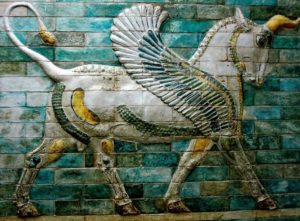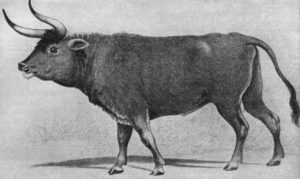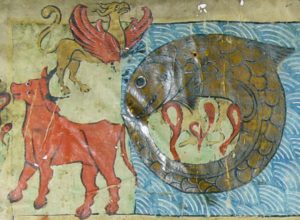Yesterday was my daughter’s birthday, and her favourite thing in the world is unicorns. Perhaps this is because the unicorn makes a hidden appearance in her parasha, this week’s parasha, Vayak’hel-Pekudei. In summarizing the construction of the Mishkan, the Torah notes that it was made with the skins of the tachash (Exodus 35:7). The tachash is a mysterious animal whose true identity is entirely unknown. The Talmud (Shabbat 28b) states that it was a unique mammal species, wild and undomesticated, with a singular horn on its head. It came specifically in the time of Moses to be used for the Mishkan, and has since disappeared. The Talmud goes on to suggest that it was probably the same animal that was brought by Adam as a sacrifice in the Garden of Eden. This ties to another passage in the Talmud (Avodah Zarah 8a) that explains how Adam brought a thanksgiving offering to God, of a unique animal with a single horn, as it states in Psalms 69:32 that “it shall please God better than an ox with horn and hooves.” Elsewhere (Chullin 60a), the Talmud adds that this special animal emerged fully formed, horn-first, from the Earth. The Sages hold that having horn and hooves means it was probably kosher!
Interestingly, the unicorn is one of those mythical animals that appears in cultures around the world. Archaic seals from the Indus Valley, one of the earliest civilizations in history, bear unicorns. The ancient Persian palace in Shushan displays a beautiful unicorn on its walls. Here there is an intriguing connection, because the Shushan palace was likely the home of Queen Esther. Our Sages described Esther as a paragon of purity, and the Zohar (III, 276a, Ra’aya Mehemna) goes so far as to say she never actually slept with Achashverosh. Rather, Mordechai worked some magic and brought a succubus to be with the king instead! In medieval literature, the wild and powerful unicorn could only be subdued by the purest of maidens. Even the wise Leonardo da Vinci wrote:
The unicorn, through its intemperance and not knowing how to control itself, for the love it bears to fair maidens forgets its ferocity and wildness; and laying aside all fear it will go up to a seated damsel and go to sleep in her lap, and thus the hunters take it.
So, perhaps there is some connection after all between the pure maiden Esther and the unicorn in Shushan’s palace.
More commonly, the unicorn is referred to as a re’em. We find this in Numbers 23:22, where God is said to have taken Israel out of Egypt with the horn or “strength of a re’em”. Meanwhile, Job 39:9-11 wonders whether the wild re’em “would agree to serve you? Are you able to hold down the re’em? …Would you rely on his great strength?” Some (like Rav Sa’adia Gaon) believe that this is referring to the rhinoceros. Others hold that it must be the extinct aurochs, the wild progenitor of the modern cow. Archaeological evidence suggests that the Akkadian word rimu referred to the aurochs. It is quite possible that the English “ram” also has a common origin with the word re’em. However, these animals have two horns, so they wouldn’t fit with the single-horn description of the re’em. What else might it be?
David’s Unicorn
Sometimes (like in Shushan above), the unicorn is depicted with wings, reminiscent of the Greek mythological beast known as Pegasus. The earliest mention of this animal is from the Hittites (the Torah’s Hittim, listed among the tribes in Canaan), who called it pihassas, “lightning-horse”. The majestic winged-horse/unicorn flies down from the clouds, hence the association with lightning. Similarly, the Midrash (Yalkut Shimoni II, 688) records a fascinating story in which the majestic re’em/unicorn lifts David up into the clouds:
David was once walking in the wilderness and climbed upon a hill—which turned out to be, not a hill, but the back of the massive re’em. The re’em raised David up to the clouds (either because it was so big when it stood up, or perhaps because it had wings and took off). David prayed to God to save him, so God sent a lion to scare away the re’em. Now, of course, David was face-to-face with a lion, so he asked God to save him from the lion! This is the meaning behind David’s words in Psalms 22:22: “Save me from the mouth of the lion, and from the horns of re’emim rescue me.”
The Talmud (Zevachim 113b), too, notes the massive size and power of the re’em. It was so large that apparently it could not fit in Noah’s Ark. How did it survive, then? Either because it lived in the Holy Land, which was not flooded (according to one opinion), or only its calves were taken into the Ark. This description of a massive land beast, a kosher ruminant, with horns, resembles the description of another great beast: Behemoth.
End of Days Showdown
Behemoth is first mentioned in Job 40:15. This beast is usually paired with Leviathan, the great sea-dragon. In Jewish tradition, it is said that in the End of Days, at the feast of Mashiach, the meat of the Behemoth and the Leviathan will be served to the righteous. The Midrash (Vayikra Rabbah 13:3) describes the great battle that will take place between the two monsters beforehand: “Behemoth will impale Leviathan with his horns and tear him up, while Leviathan will [simultaneously] slice Behemoth with his fins.” The Sages add that this will be a kosher shechitah!
While it isn’t clear if Behemoth is the same as the tachash or the re’em, their closely-similar descriptions suggest that perhaps they are all referring to the same mysterious beast, the unicorn. (Some identify Behemoth with a hippopotamus. However, a hippo is not horned, and is not a kosher animal so it could not be consumed by the righteous. The unicorn, on the other hand, is both horned and deemed kosher by the Sages, as noted earlier.) That Behemoth and Leviathan reappear at the End of Days is no coincidence, for both symbolize Mashiach in their own way. We have already discussed in the past the association between Mashiach and the serpent-dragon. How about the unicorn?
The Tanakh famously describes Mashiach as riding upon a donkey. The Talmud (Sanhedrin 98a) records how King Shapur of Persia (who was a friend of the Sages) ridiculed a donkey-riding messiah and said: “Let me give him my susia barka!” The term literally means my “lightning horse”, ie. Pegasus. (Remember the winged unicorn in the Persian palace?) The Sages rebuffed his offer and said: “Do you have a horse of a hundred colours?” Apparently, Mashiach’s ride is miraculously multi-coloured. And this is the same way that the Talmud (Shabbat 28a) describes the tachash mentioned in this week’s parasha: “Why do we translate [tachash] into the Aramaic sasgona [or sasgavanah]? Because it rejoices (sas) in its many colours (gavanim).” The Aramaic translation of the Torah’s “tachash” can be read “sasgavanah”, meaning “horse of many colours”. And that brings everything full circle: the unicorn of many colours is the winged “lightning-horse” of Mashiach! Wonderfully, this can solve three big mysteries:
First, we know that Mashiach is supposed to come “riding upon the clouds” (Daniel 7:13), but this contradicts the statement that he rides a donkey (Zechariah 9:9)! Second, we know that Mashiach is supposed to slay Leviathan, but we don’t know exactly how. Third, where does the unicorn originate, and what is its relationship to the unicorn that was sacrificed by Adam?
The solution to the first problem is that the “donkey” of Mashiach may actually be a winged, multi-coloured horse—which would allow Mashiach to “ride upon the clouds”, too. (Recall also how the Midrash describes David, the ancestor of Mashiach, as going “up into the clouds” riding the re’em.) The solution to the second problem is that it is Mashiach’s unicorn that destroys Leviathan, and dies itself in the process. These two frightening beasts, alone in Creation, finally neutralize each other, and that solves the final mystery: It is taught that a pair of leviathans (hataninim hagedolim, Genesis 1:21) were created on the Fifth Day, but they were so terrible that God slew one so that they wouldn’t reproduce. A singular Leviathan remained. It appears that something similar might be true of the unicorn: a pair were created, but Adam sacrificed one in Eden. (It could very well be that the skins of that shechted unicorn were those used for the Mishkan.) One unicorn remained. Finally, amidst the great battles at the End of Days, the one remaining unicorn and the one remaining leviathan obliterate each other for good, taking all the troubles of the world with them.
Having said all that, it is probably worth concluding with the old adage: One who disregards the truth of Midrash is a heretic; one who regards Midrash as literally true is a fool!
Shabbat Shalom



